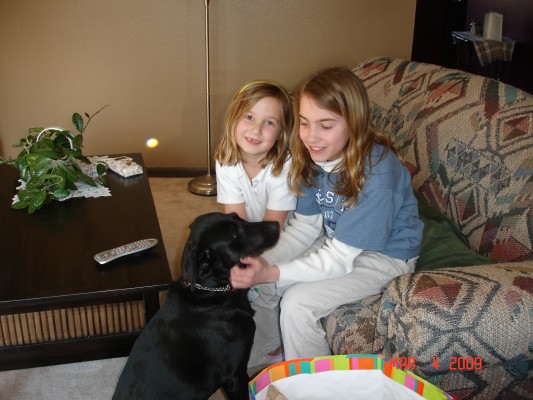My husband gently guided our frail black lab out our back door and into the yard, where she would do her “dog duty” as she has for the past seven years. It’s a task that once took seconds and now lasts a couple of slow minutes. He came back into the kitchen and casually remarked to me, “That will teach a person compassion — having a blind dog. I see it in the kids too.”
I’ve also seen “it” more in our home since our beloved dog became sick: compassion. Compassion, defined to me recently as, “the observation and recognition of suffering and the desire to make a person feel better.” Basically, someone’s hurting and you want to help. I’ve learned that’s a simple, “overarching” definition, and it can be transferred to many different areas, including bullying, the environment, and animal rights (and family pets, of course).
At home our two daughters are learning firsthand about compassion without even realizing it. When they stroll outside with our dog and keep her leash shorter so she’s closer to them. When they automatically give her bite-sized treats and share without making her sit first to earn it. When they cover her with an extra blanket and place a little pillow under head when she’s resting. She’s quickly lost half her body weight, fading into a skeleton in front of our eyes, her jagged bones more apparent than soft fur.
Compassion. It’s a big word they’ve heard but maybe not thought about deeply before now. I’ll try to be strong for my daughters and to show them compassion when I break the sad news that their special dog, their first pet ever, will not be here for Christmas. I’ll tell them how proud I am of them for showing their dog compassion when she was sick. I’ll tell them compassion is a core value in our Catholic faith, and it’s a value they must practice with other people (and pets) everywhere they are — at school, on the sports field, dance floor and the theater stage.
As we do each Advent season, we’ll read a few of our favorite versions of the Christmas story. Then we can talk more about compassion too. Who showed Mary and Joseph compassion along their way to Bethlehem and who did not? What acts of compassion were shown to Baby Jesus and his Mom and Dad after his miraculous birth?
It’s easy to practice compassion during the Advent season with many volunteer opportunities available, an abundance of organizations highlighting needs. Volunteering as a family is a great way to show you care about others in your community.
Each Advent our parish provides a “giving tree” with mittens and hearts created out of construction paper with requests hung on the branches as ornaments. Earlier this month after Sunday Mass, my 11-year-old and I plucked several “ornaments” from the tree. When we read them together at home, my teenager wondered aloud why anyone would want a jar of peanut butter for Christmas. She can have a “PBJ” sandwich whenever she craves one. I explained to her that peanut butter is pricey for many people, even considered a luxury, and it’s always on the local food pantry’s wish list. The largest blue mitten opened her eyes the most.
My youngest thought it was unusual when we shopped for one towel and one washcloth – why not more? – requested on the small orange heart. Yet, she was most excited to shop for a “squeaky toy,” listed on a green heart, for the pastor’s adorable little white canine. It was her way to give another dog the Christmas gift that, she already knew in her heart, she wouldn’t be giving her own dog.
How does your family practice compassion during Advent and all year long?
Copyright 2013 Kim Seidel
About the Author

Guest
We welcome guest contributors who graciously volunteer their writing for our readers. Please support our guest writers by visiting their sites, purchasing their work, and leaving comments to thank them for sharing their gifts here on CatholicMom.com. To inquire about serving as a guest contributor, contact editor@CatholicMom.com.



.png?width=1806&height=731&name=CatholicMom_hcfm_logo1_pos_871c_2728c%20(002).png)
Comments